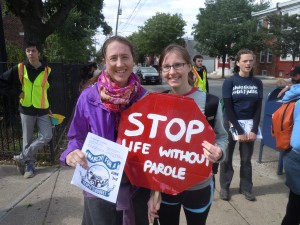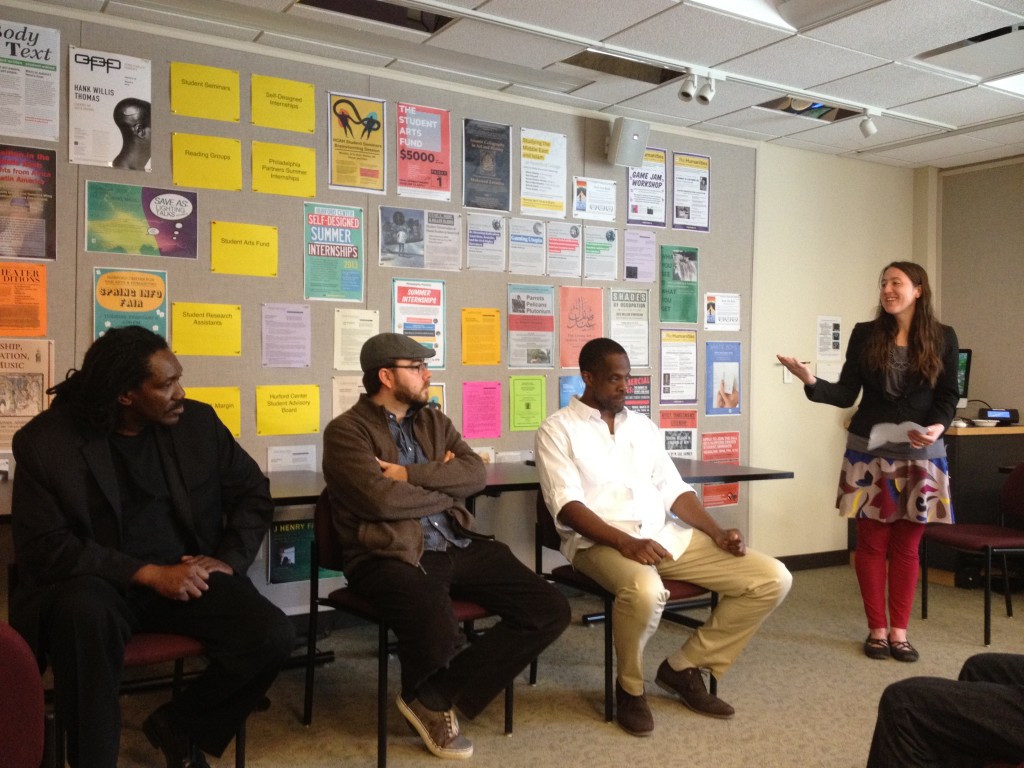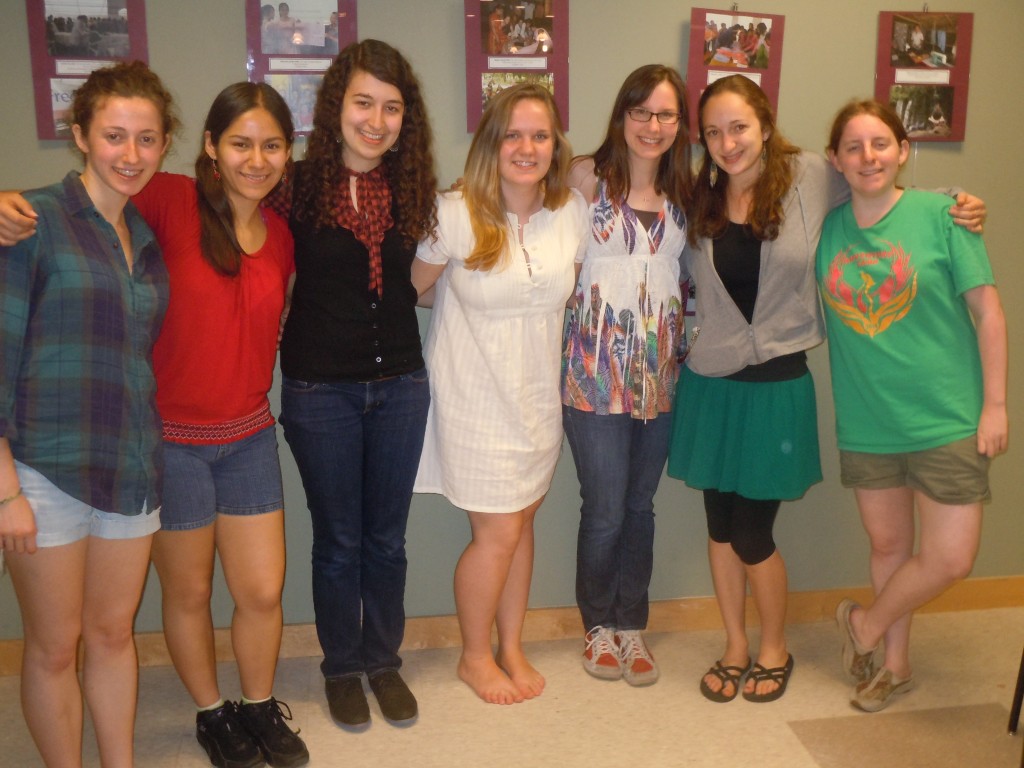Kristin Lindgren
Director, Haverford Writing Center
Navigating the long driveway to the State Correctional Institution at Graterford, I am struck by its bucolic setting. The prison is surrounded by cornfields, sunflowers, picturesque Mennonite farms with red barns and silos. Deer are grazing along the road. The air is thick with the sound of crickets and frogs. It’s jarring, every time, to reach the end of the road, where the massive gray prison suddenly comes into view, along with its nine guard towers, coils of razor wire, and stenciled identification on the outside of each windowless block: Z-1, Z-2, Z-3, Z-4, Z-5. Like most prisons, SCI-Graterford is located well outside the urban area from which most of its residents come. Still, Graterford is within driving distance of Philadelphia. Every Friday evening, Haverford students and alumni, sometimes accompanied by faculty and staff, make the trip.

Haverford House Fellows Molly Minden ’12 and Emily Dix ’12 participate in a march from Philadelphia to Harrisburg organized by Decarcerate Pennsylvania.
The largest maximum-security prison in Pennsylvania, Graterford is a forbidding place. Why would Haverford students want to spend time there? Students travel around the globe to learn about sociopolitical issues, to contribute to social justice initiatives, and to interact with widely varied cultures and communities. Participating in the Restorative Justice Project at Graterford, a little over an hour from campus, students have the opportunity do all of these things. They engage with a world very different from their own, one that is often obscured from view.
Upon entering the prison, we encounter layers of security: fingerprint identification, metal detectors, ultraviolet hand stamps, plastic ID bracelets, thorough searching of any papers we have brought into the prison. We are allowed to carry with us our prison IDs, car keys, driver’s licenses, and papers relevant to the workshop or meeting we’re attending. Nothing else. Books or other materials must be previously approved and entered on the gate memo. No written communication can come in or out. Our clothing is closely inspected: an exposed shoulder or low-cut blouse can bar entry. We are subject to sudden and seemingly arbitrary changes in the rules and regulations. Welcome to the carceral state.
The circulation of images is controlled even more tightly than the circulation of visitors. No cameras of any kind are allowed inside. The only photos that leave Graterford are those taken in the official visiting area by a prisoner employed as a photographer, in front of a painted or digital backdrop that erases any visual cues of the prison. All of the men keep precious personal photos—sometimes a handful, sometimes hundreds—in their cells. Childhood and family photos connect them to the past and to life outside the walls of Graterford. But visual records of their lives inside, and of the architecture and environments that shape their days, are largely absent.

Haverford House Fellow Molly Minden ’12 introduces a panel of speakers at a screening of Broken On All Sides, a documentary about “Race, Mass Incarceration and New Visions for Criminal Justice in the U.S.”
Prison Obscura addresses this absence, offering both micro and macro views: intimate portraits and self-portraits of incarcerated youth and adults as well as aerial satellite photographs of prison complexes. Sponsored by the Cantor Fitzgerald Gallery and the Hurford Center for the Arts and Humanities, this exhibition reminds us that the work of the humanities—the making and interpreting of images and stories—is central to understanding lives different from our own and, at times, to instigating actions that address systemic injustice. As Philadelphia public schools are being radically defunded, the state of Pennsylvania is spending $400 million to construct two new prisons near Graterford. The photographs in this exhibition give us a window into the human consequences of mass incarceration.
Prison Obscura, along with related gallery talks and film screenings, builds on Haverford’s involvement with the Restorative Justice Project (RJP) at Graterford. The prevailing notion of networks formed inside prisons involves gangs, drugs, and crime. The RJP creates, instead, a network of support based on repairing harms and restoring relationships, with attention to the needs of victims, offenders, their families and communities. In recent years, Haverford’s Center for Peace and Global Citizenship (CPGC) has built a sustained relationship with Graterford that enables students, alumni, faculty, and staff to learn about restorative justice from the incarcerated men who lead the RJP while providing logistical support for their programming.
Juliaty Hermanto ’12 and Cara Curtis ’10 first engaged me in conversations about restorative justice and the prison industrial complex. Juliaty, whose senior thesis explored the accessibility of prison programming, helped to establish a partnership between the prison and the Haverford Writing Center. Emily Bock ’11, a law student at Temple University, became involved with the RJP as an undergraduate, continued her work as a CPGC Haverford House post-bac fellow, and plans to incorporate the restorative justice model into her legal career. Emily Dix ’12 and Michael Riccio ’13 worked with the RJP during their Haverford House fellowship year. Rilka Spieler ’14, Ariel Levin ’14, and Alison Marqusee ’16, members of the student-run group Rethink Incarceration, are currently core volunteers.

Haverford House Fellow Emily Dix ’12 led a reading group on the topic of restorative justice. Emily and three of the group’s participants, Ari Levin ’13, Rilka Spieler ’13 and Alison Marqusee ’15 went on to volunteer alongside the men leading the Restorative Justice Project at SCI Graterford.
Countless other students have become involved through CPGC-sponsored Inside-Out courses, in which incarcerated men and women learn alongside undergraduates. In collaboration with CPGC Domestic Program Coordinator Janice Lion, Sarah Morris ’05 brought the Inside-Out curricular model, developed at Temple University, to Haverford. Barbara Toews, the instructor, has been instrumental in building a relationship between the Haverford community and area prisons, and Graterford staff members have offered crucial support. The campus Tri-college community (Swarthmore, Bryn Mawr, and Haverford) shares in this work through courses across the disciplines that incorporate the study of incarceration, reconciliation, social justice, and self-representation.